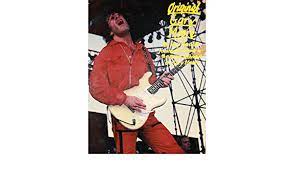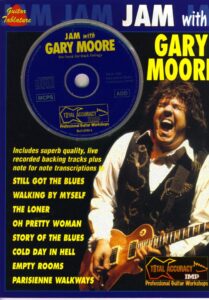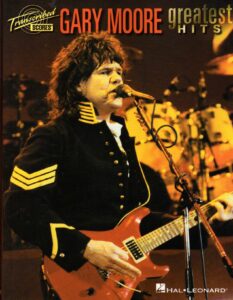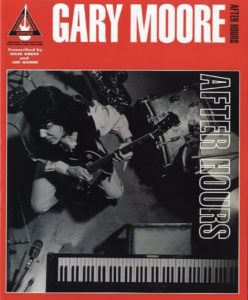Come join us now, and enjoy playing your beloved music and browse through great scores of every level and styles!
Can’t find the songbook you’re looking for? Please, email us at: sheetmusiclibrarypdf@gmail.com We’d like to help you!
Table of Contents
Gary Moore (sheet music in the #smlpdf)

Best Sheet Music download from our Library.
Gary Moore Parisienne Walkways Guitar With Tabs
Gary Moore – Ballads Songbook (Guitar Book)
Gary Moore – Greatest Hits Full Band Score
Gary Moore – Jam with (with MP3 audio tracks to play along),
Songs include:
- Empty Rooms
- Oh Pretty Woman
- Over The Hills And Far Away
- Parisienne Walkways
- Still Got The Blues
- The Loner
- Walking By Myself
Gary Moore – Parisienne Walkways (+Mp3 Backing tracks) (Guitar Tabs)
Gary Moore – Still Got The Blues-Songbook
Gary Moore After Hours Guitar Songbook with Tablature, including:
“Cold Day in Hell”
“Don’t You Lie to Me (I Get Evil)”
“Story of the Blues”
“Since I Met You Baby”
“Separate Ways”
“Only Fool in Town”
“Key to Love”
“Jumpin’ at Shadows”
“The Hurt Inside”
“Nothing’s the Same”
Gary Moore Original Songbook, GUITAR TABS (AUDIO MP3 + PDF) Wolf Marshall, including the songs:
Don’t take me for a loser
Always gonna love you
End of the world
Don’t let me be misunderstood Hold on to love
Devil in her heart
Out in the fields
Once in a lifetime
All messed up
Run for cover
Reach for the sky Military man
Still in love with you
Gary Moore Parisienne Walkways Guitar Tabs
Gary Moore-Cold day in Hell
Gary Moore The Guitar Style Of Guitar TABs, including the songs:
Cold Day in Hell
Empty Rooms
End of the World
Hold on to Love
The Loner
Moving On
Only Fool in Town
Out in the Fields
Over the Hills and Far Away
Still Got the Blues
Teenage Idol
Wild Frontier
Please, subscribe to our Library.
If you are already a subscriber, please, check our NEW SCORES’ page every month for new sheet music. THANK YOU!

Gary Moore Greatest Hits Full Album 2022 ~ Gary Moore Ballads & Blues | The Best of Gary Moore
Tracklist:
00:00 – Maple Leaf Rag 03:03 – Elite Syncopations 06:31 – The Easy Winners 10:05 – Felicity Rag 12:51 – The Entertainer 16:20 – The Strenuous Life 19:43 – Combination March 23:09 – Ragtime Dance 26:54 – Cascades 30:13 – Peacherine Rag 33:31 – Something Doing 36:37 – Country Club 40:13 – Scott Joplin New Rag 43:53 – Sunflower Slow Drag 47:10 – Paragon Rag 50:57 – Heliotrope Bouquet 54:25 – Swipesy 57:56 – Search Light 01:02:26 – Rose Leaf Rag 01:06:04 – Fig Leaf Rag 01:09:33 – Original Rags 01:13:24 – Pine Apple Rag 01:16:50 – Gladiolous Rag 01:21:16 – The Ragtime Dance 01:25:01 – Sugar Cane 01:28:20 – Palm Leaf Rag 01:31:31 – A Breeze from Alabama

Please, subscribe to our Library.
If you are already a subscriber, please, check our NEW SCORES’ page every month for new sheet music. THANK YOU!

Gary Moore (short bio)
Robert William Gary Moore (b. April 4, 1952 Belfast, Northern Ireland – d. February 6, 2011, Estepona, Málaga, Spain) was a Northern Irish blues rock and hard rock musician, composer and producer , known worldwide for being lead guitarist in bands such as Thin Lizzy, Colosseum II and Skid Row, and for his extensive solo career as a vocalist as well.
Youth and its beginning in music
He was born in the city of Belfast in Northern Ireland, as one of the five children of Bobby and Winnie Moore. When he was only 10 years old, his father gave him a used Framus acoustic guitar, but it was not until he was 14 that he got his first electric guitar, a Rosetti model Lucky Squire, which according to him was very bad and even broke the back while playing.
In 1968, at the age of 16, he left home due to the bad relations between his parents and the political problems in his country, settling in Dublin. In that city and thanks to his talent as a guitarist he joined Skid Row made up of Brendan Shields on bass, Noel Bridgeman on drums and Phil Lynott on vocals.
In 1970 they had the opportunity to open a concert for one of Gary’s influences, Peter Green, former member of Fleetwood Mac, who helped them sign a contract with the CBS Records label and who, in addition to this, sold him one of his Gibson guitars. Les Paul 1959, which became the first guitar he bought. After participating in the albums Skid in 1970 and 34 Hours the following year, he decided to leave the group to begin his solo career in mid-1972. With the help of some session musicians he released his debut album, Grinding Stone in May. in 1973, under the nickname The Gary Moore Band.
The passage through Thin Lizzy and Colosseum II
In 1974 he moved to England where he met his friend Phil Lynnott, leader of Thin Lizzy, who invited him to participate in some live performances to replace Eric Bell. He was then invited to record the lead guitar on the song “Still in Love With You” from the Nightlife album published at the end of the same year.
In 1975, drummer Jon Hiseman of the British band Colosseum summoned him to reform the group, which he called Colosseum II, in which keyboardist Don Airey and bassist Neil Murray also participated, among other musicians.
In mid-1977 and after the departure of guitarist Brian Robertson from Thin Lizzy, Lynnott called him to participate in the tour of the United States opening Queen concerts and then in December 1978, as an active member of the band, he participated in the recordings of the album Black Rose: A Rock Legend published the following year.
Solo career: The early years
In 1978, after supporting Thin Lizzy on their tour of the United States, he decided to return to his solo career with the help of his former bandmates and friends Phil Lynnott, Don Airey and John Mole, among others.
Their second album, Back on the Streets , was released in September of the same year and debuted at number 70 on the UK Albums Chart.
It contains his first big hit in the English country “Parisienne Walkways”, which managed to enter the top 10 of the UK Singles Chart.
Gary Moore – Parisienne Walkways live
With the arrival of the new decade, Gary traveled to Los Angeles (California), where he gathered some musicians to found the G-Force project, which released the album of the same name in 1980 and which did not obtain very good results on the music charts but did on the promotional tour, with two consecutive nights at the prominent Club Marquee in London, among other presentations in Great Britain.
A short time later he separated the group after receiving an invitation from Greg Lake to participate in his solo career.
In 1982 and after collaborating on some albums by Greg Lake and Cozy Powell, he decided to take his career seriously and therefore released the album Corridors of Power , which included the heavy metal genre for the first time and which caught the attention of the American market. ranking at number 149 on the Billboard 200 list and, in turn, obtaining position 30 in the United Kingdom.
During the promotional tour simply called Corridors of Power Tour, he played for the first time at the Reading Festival in England on August 26, 1982.
The following year he played for the first time in Japan with great success, to the point that the Virgin Records label recorded one of the performances and published the first live album called Rockin’ Every Night – Live in Japan , only for the Japanese market.
Just some months later the live album, Live at the Marquee, was released.
At that time, Gary entered the studios to release the fourth studio album Victims of the Future in late 1983, which contains a cover of Yardbirds’ “Shapes of Things” and the power ballad “Empty Rooms.”
The success it generated in world markets allowed it to play at the largest festivals in several European countries, including Monsters of Rock, and it also arrived in the United States for the first time in mid-1984 with very good results. In that same year, the Jet Records label re-released the album Dirty Fingers for the European market , which had originally only been published in Japan.
Second half of the eighties
was released. By the end of 1984 , We Want Moore! , considered one of his best live records and which was recorded during the Victims of the Future Tour in several cities in the Northern Hemisphere.
The following year and with the help of some musicians such as Paul Thompson, Glenn Hughes and Bob Daisley he recorded Run for Cover , which reached very good positions on the European charts and his first silver album in the United Kingdom.
From this the single “Out in the Fields” was extracted, which featured the collaboration of Phil Lynott, this being also his last studio record before his death at the beginning of 1986.
The following year During the second half of 1986 he returned to the studios to release the album Wild Frontier , with a sound far from heavy metal and a little more intimate, but with hard rock as the main style, which can be seen in songs like “Over the Hills and Far Away” and The Easybeats’ version, “Friday on My Mind.”
Up to that point, it was their most successful album, reaching number 1 on the Finnish and Norwegian music charts. During the promotional tour, Gary invited Eric Singer on drums and also recorded the first audiovisual record called Live at Isstadion Stockholm.
In 1989 he released After the War , which is considered the last great album loaded with heavy metal and hard rock , after in 1990 he changed his sound to his main influence, blues . This production achieved great success in European markets with a gold record in Germany and the third consecutive silver record in the United Kingdom.
The nineties and the return to blues rock
By the end of 1989 Gary decided to return to his most influential styles; blues , and for this he returned to work with Don Airey and Bob and blues rock Daisley as well as with his former partner in Thin Lizzy, drummer Brian Downey. With this new lineup he recorded the album Still Got the Blues , which was a suitable title for what was this new stage in his career, moving away from heavy metal but without completely losing hard rock .
The success was total in the main European markets, reaching number 1 in Finland and Sweden, while in the United Kingdom it reached platinum status and in turn was certified with the first and only gold record in the United States in 1995. From the album “Still Got the Blues (For You)” was extracted The power ballad , which is his best-known song worldwide.
In 1992 he published After Hours , which featured the collaboration of guitarist BB King on the song “Since I Met You Baby.”
It also peaked at number 4 in the United Kingdom, the highest position for a studio album by the late musician.
During the respective musical tour, live material was recorded in the United States and at the Royal Albert Hall in London for the 1993 live album Blues Alive .
In that same year, together with bassist Jack Bruce and drummer Ginger Baker, former Cream musicians, he founded the power trio BBM and released Around the Next Dream in 1994, which was accompanied by an extensive tour of Europe until their separation at the end of that year.
In 1995 he published a new work called Blues for Greeny , a tribute album to guitarist Peter Green, former member of Fleetwood Mac, who is one of his main influences.
Two years later he released Dark Days in Paradise , with which he returned in part to hard rock , but without completely losing blues rock .
The next work, A Different Beat , was the guitarist’s least known album since it did not attract the attention of the music charts. Like the previous album, it continued with hard rock and blues rock , but as its name indicates, it included some new sounds such as almost danceable songs, in an orientation more towards pop music.
The 2000s
With the arrival of the new millennium and after experimenting with some styles in his two previous albums, he decided to return to the blues and to do so he published the album Back to the Blues in 2001 , which put him back on the world’s music charts.
A year later and together with Cass Lewis, former bassist of Skunk Anansie, and drummer Darrin Mooney of Primal Scream, he created a new project and published Scars , which continued with the same theme of his main works from the early 1990s.
At that same time his main record label, Virgin Records, was constantly publishing compilation albums such as The Best of the Blues and Parisienne Walkways – The Blues Collection , among others.
In 2003 Sanctuary Records published the first audiovisual record in DVD format called Live at Monsters of Rock , which was precisely recorded at the Monsters of Rock festival during a tour of England.
The following year he released Power of the Blues , which featured the participation of Bob Daisley, a bassist with whom he had great success in the eighties.
By the end of 2005 he ended his contract with the Sanctuary label to sign with the American Eagle Records. With this new record label he released Old New Ballads Blues in 2006 , which included some covers and as the name suggests, the vast majority are blues- based ballads .
The following year with Close As You Get , he continued with the same characteristic of the previous work with some covers by musicians such as Chuck Berry, Sonny Boy Williamson II, John Mayall and Son House.
In September 2008 , Bad for You Baby was published , which featured some covers such as “Walkin’ Thru the Park” and “Someday Baby” by Muddy Waters and “I Love You More Than You’ll Ever Know” by Blood, Sweat & Tears.
The following year, the Eagle label released the compilation album Essential Montreux , which includes five albums recorded live at the Montreux Jazz Festival in their presentations in the years 1990, 1992, 1995, 1997 and 2001.
After his death, the Eagle label released the live album Live at Montreux 2010 , which was his last filmed performance, and the following year the second posthumous album Blues for Jimi was released , which was recorded in 2007 in tribute to guitarist Jimi Hendrix.

Death
On February 6, 2011 and at the age of 58, he died while sleeping in one of the rooms of the Kempinski Hotel Bahía in the city of Estepona in Spain. According to his girlfriend, with whom he was spending a vacation in that city, they had dinner quietly and then moved to the room without problems. She raised the alarm at 4:00 am, when the hotel service arrived at the room and later the police, who massaged her heart to save it, but unfortunately without success.
According to the Spanish police, his body did not show signs of violence, so no type of investigation would be opened. The autopsy performed on the guitarist’s body revealed that his death was caused by a heart attack. The news of his death was announced by Thin Lizzy’s manager, Adam Parsons.
His remains rest in the cemetery of St. Margaret in Rottingdean in the county of East Sussex in England, whose ceremony only included his family and close friends.
Guitars
He got his first electric guitar at the age of 14 and it was a Rosetti Lucky Squire model. However, the first one he bought with his own means was a used 1959 Gibson Les Paul, which was sold to him by former Fleetwood Mac member Peter Green.
Over the years he used various models of Gibson guitars, such as the Firebird III, Firebird V and the Gibson Flying V. At the same time, he began to use various Fender brand guitars, such as the Stratocaster and the Telecaster.
In the 1980s he began using more varieties of guitars. One of his favorite brands during that time was Ibanez, in its models Roadstar RS1000, Artist AR300, Destroyer DT-330 and DT-380 and the Roadstar II in metallic blue and metallic gray, which can be seen in the promotional videos. of “Empty Rooms” and “Shapes of Thing”, respectively.
Throughout his extensive career he has used dozens of these instruments such as the Jerry Jones baritone guitar, the Ozark Resonator 3515BTE and various models from the brands Dean Guitars, PRS Guitars, Vigier, Charvel and Jackson, among others. He has also played the main acoustic guitars of the Taylor Guitars and Takamine factories in their six- and twelve-string versions.
Also, thanks to million-dollar contracts with the aforementioned factories, he had the opportunity to personalize some of them, such as his own version of the Jackson Soloist, which he called Flags, since it was full of various flags from around the world. This was released as a limited edition between 1988 and 1989, mainly for the European market. The same thing happened with the Hamer brand, which created a special version for him of its Floyd Rose model in black and white colors, between 1984 and 1985, which was used in the video for “Out in the Fields.”
It is worth mentioning that the Gibson company manufactured a Les Paul model guitar with exclusive specifications for him in 2000. After his death and as a tribute to the late musician, that guitar was released under the name Gary Moore Les Paul in 2013, but only for the United States and Great Britain.
Legacy and tributes
Since his death, a wide variety of musicians have dedicated words to him, both in interviews and on their own websites, recognizing his enormous legacy and work in music. Some of them have been vocalist and friend Ozzy Osbourne, Brian Downey and Scott Gorham of Thin Lizzy, current Kiss drummer and Gary’s musician on the Wild Frontier tour Eric Singer, Kirk Hammett of Metallica, Doug Aldrich of Whitesnake, Tony Iommi of Black Sabbath, Irish singer Bob Geldof, Roger Taylor and Brian May of Queen, opera vocalist Andy DiGelsomina, Ricky Warwick of The Almighty, Glenn Hughes, Bryan Adams, Henry Rollins and Mikael Åkerfeldt of Opeth, among many others.
In turn, there have been several artists and bands that have paid tribute to him in live concerts and in their respective albums, playing some of his greatest hits.
On April 18, 2011, several Irish musicians, such as Eric Bell and Brian Downey of Thin Lizzy, performed a concert in his honor at the Whelan’s Bar venue in Dublin, which they called The Gig for Gary. This same type of tribute was held in Budapest on April 4, 2012, at the PeCsa Music Hall venue.
The British rock magazines Classic Rock , Guitarist and Total Guitar also published various articles in his honor. In the case of Guitarist , it revealed unpublished material of photographs of Gary taken in 2009. For several days after his death, thousands of fans expressed their lament through Twitter, including Sharon Osbourne and Danny Jones frontman of McFly .
Finally, some cities around the world have honored his career with various tributes, such as the Hungarian capital Budapest, which planted a memorial tree in Eiffel Square with a fingernail-shaped plaque with his name.
In July 2013 in the Norwegian city of Skånevik — specifically on a small island off its coast — they installed a statue with his figure, since the Skånevik Blues Festival is held there every year and in the latest versions he was the artist who he got on that stage more times.
Discography
Main article: Annex: Discography of Gary Moore
Studio albums
- 1973: Grinding Stone
- 1978: Back on the Streets
- 1982: Corridors of Power
- 1983: Victims of the Future
- 1984: Dirty Fingers
- 1985: Run for Cover
- 1987: Wild Frontier
- 1989: After the War
- 1990: Still Got the Blues
- 1992: After Hours
- 1995: Blues for Greeny
- 1997: Dark Days in Paradise
- 1999: A Different Beat
- 2001: Back to the Blues
- 2002: Scars
- 2004: Power of the Blues
- 2006: Old New Ballads Blues
- 2007: Close As You Get
- 2008: Bad for You Baby
